Sweet, simple, luscious glazed lemon poppy seed Bundt cake to bring sunshine to even the coldest of days.
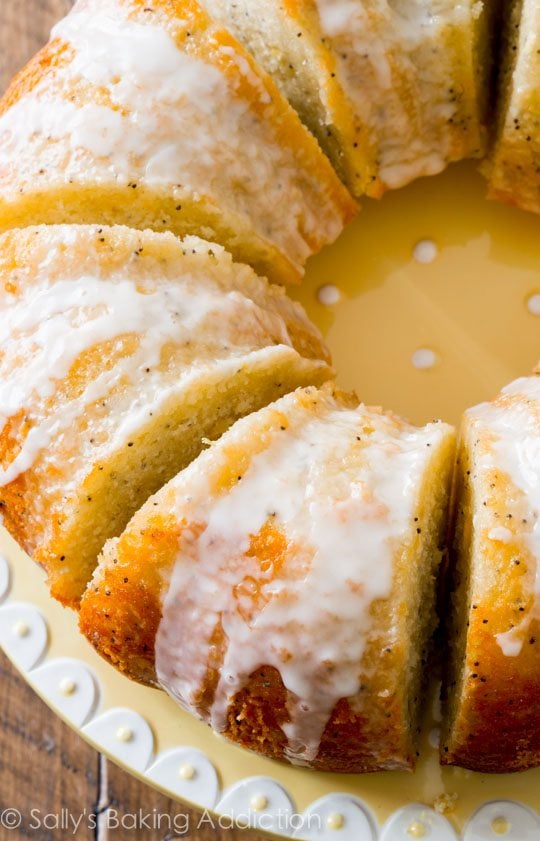
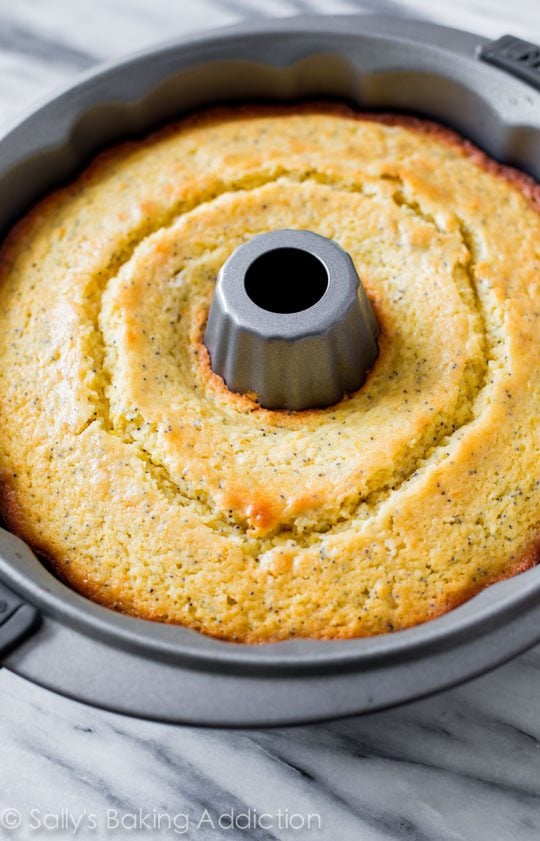
When it comes to lemon desserts, what I run into often is finding the right balance between tart and sweet. And too much flavor vs. no flavor at all. But this lemon Bundt cake nails it. Lemon is worked into every single component:
- Lemon poppy seed cake
- Lemon simple syrup
- Lemon glaze
Even when used in each layer, the lemon flavor doesn’t taste overwhelming. The cake itself is balanced out with sweet vanilla and rich buttery flavors. The simple syrup seeps into the cake creating that mouthwatering moist texture. And the lemon glaze on top? Well that’s just a given. What’s cake without some frosting?!
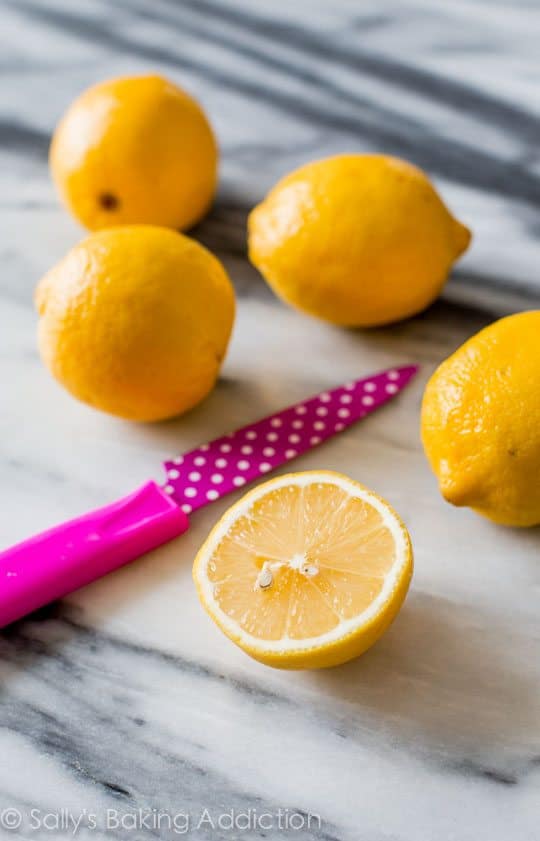
For the softest, most cakey texture (read: the best texture!)—I like to use creamed butter and cake flour in the batter. Creamed butter and sugar provide a deliciously cakey base for the recipe. And as you might remember from my red velvet cake, cake flour produces a sensationally soft cake. I don’t use it all the time for my cakes and cupcakes, but for Bundt cakes that are usually a little heavier, it’s just perfect. I actually ran out of it when I began making this cake. (A good reminder to measure out all your ingredients before beginning a recipe.) So I used all-purpose flour with some cornstarch (this is a quick “DIY” cake flour substitute).
Bundt cakes have the tendency to be a little dry, so let’s use a few eggs for tenderness and buttermilk for a moist texture. Some poppy seeds add a sprinkle of light crunch and let’s use lots of fresh lemon zest and juice for flavor.
The simple syrup, which goes onto the cake as it cools, is crucial. I’ve been toying around with using simple syrups on cakes for the past few months. A drizzle of homemade lemon syrup over this cake puts it over the top. It gives the edges, which can dry out quickly, moisture and flavor. In fact, I ate the syrup-soaked edges of the cake before even making it to the center of the cake. They’re the BEST part.
So, the simple “soaking” syrup. It’s imperative.
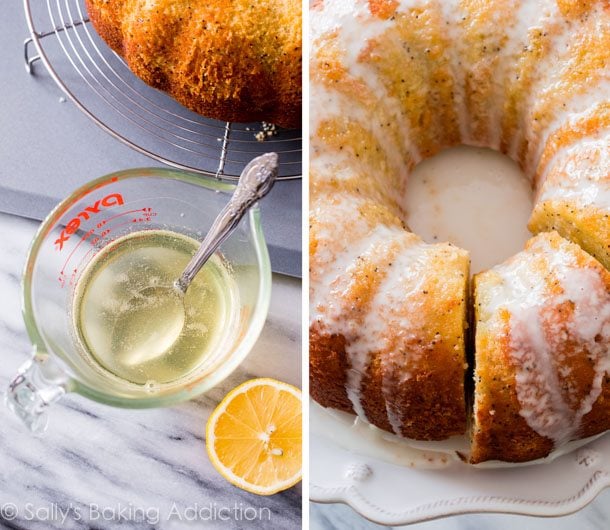
A light glaze made from confectioners’ sugar and lemon juice finishes things off.
Lick-the-plate-good.
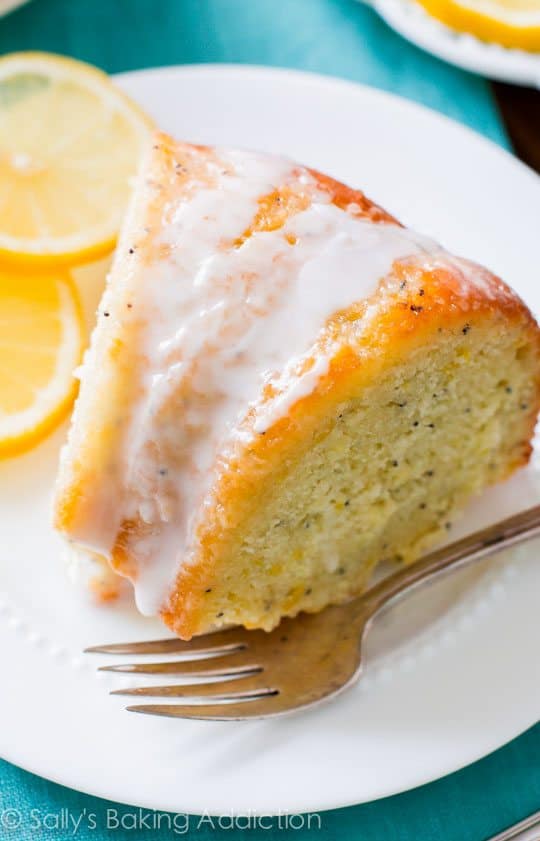
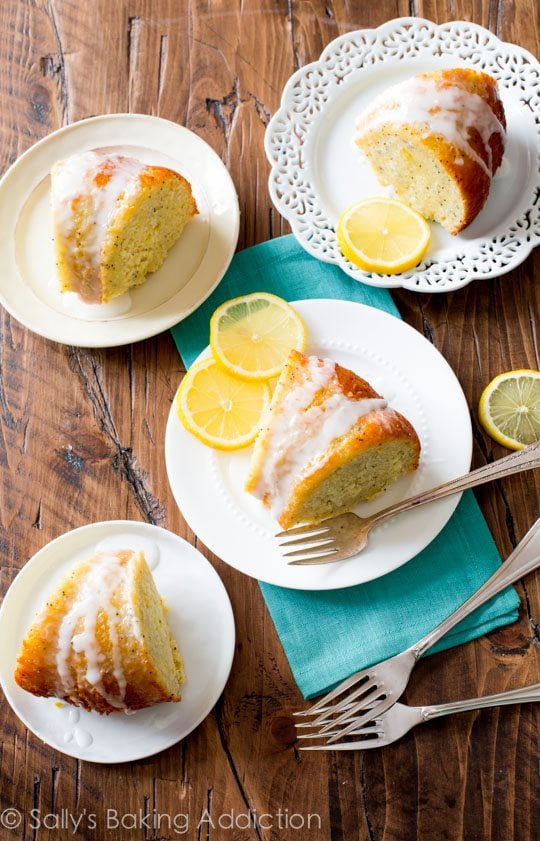
This blissful sunshine cake, everyone, is the epitome of lemon desserts. And the perfect cure for those cold winter blues.
If you crave these flavors but don’t quite need a large Bundt cake, give my lemon poppy seed bread or lemon poppy seed muffins a try.
More Lemon Treats
- Lemon Cheesecake
- Lemon Cake
- Lemon Cupcakes
- Lemon Blueberry Tart
- Lemon Crinkle Cookies
- Lemon Sweet Rolls
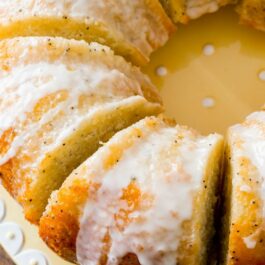
Glazed Lemon Poppy Seed Bundt Cake
- Prep Time: 45 minutes
- Cook Time: 45 minutes
- Total Time: 4 hours
- Yield: serves 10
- Category: Cake
- Method: Baking
- Cuisine: American
Description
This lemon poppy seed Bundt cake is full of fresh lemon flavor! Don’t skip the simple syrup; it’s the best part. Bundt cakes are usually a little heavier, so don’t expect a super light texture. Soft and cakey, most definitely. Avoid overbaking, which can dry out your cake. Read the recipe in full before beginning. You will need 4 and 1/2 large lemons total.
Ingredients
Cake
- 2 and 3/4 cups (344g) all-purpose flour* (spooned & leveled)
- 1/4 cup (30g) cornstarch*
- 1 teaspoon salt
- 1 teaspoon baking powder
- 1/2 teaspoon baking soda
- 1/4 cup poppy seeds
- 1 cup (16 Tbsp; 226g) unsalted butter, softened to room temperature
- 1 and 3/4 cups (350g) granulated sugar
- 4 large eggs, room temperature
- 2 teaspoons pure vanilla extract
- zest of 3 large lemons (about 1/4 cup, packed)
- juice of 2 large lemons (about 1/2 cup)
- 1 cup (240ml) buttermilk, room temperature
Lemon Simple “Soaking” Syrup
- 1/2 cup (100g) granulated sugar
- juice of 2 large lemons (about 1/2 cup)
Lemon Glaze
- 1 cup (120g) sifted confectioners’ sugar
- juice of 1/2 large lemon (or 1 medium, or 2 Tablespoons)
Instructions
- Lower the oven rack to the lower third position and preheat the oven to 350°F (177°C). Spray the inside of a 10-inch Bundt pan with nonstick spray or grease thoroughly with butter. Set aside.
- Make the cake: Sift the flour and cornstarch together into a large bowl. Whisk in the salt, baking powder, baking soda, and poppy seeds. Set aside.
- Using a handheld or stand mixer fitted with a paddle attachment, beat the butter on high speed until smooth and creamy—about 1 minute. Add the sugar and beat on high speed for 2 minutes until creamed together fairly well. Scrape down the sides and up the bottom of the bowl with a silicone spatula as needed. Add the eggs and the vanilla. Beat on medium-high speed until combined. Scrape down the sides and up the bottom of the bowl with a silicone spatula as needed. Beat in the lemon zest and lemon juice. With the mixer on low speed, add the dry ingredients in three additions alternating with the buttermilk, beginning and ending with the dry ingredients, and mixing each addition just until incorporated. Do not overmix. The batter will be slightly thick.
- Pour/spoon the batter evenly into the Bundt pan. Bake for 40-50 minutes or until a toothpick inserted into the cake comes out clean. Cover the cake loosely with aluminum foil if you begin to see the top browning quickly. Once done, remove from the oven and allow to cool for 10 minutes inside the pan.
- During this time, make the simple syrup. Combine the granulated sugar and lemon juice in a small saucepan over medium heat. Stirring constantly, cook until the sugar has dissolved. Remove from heat and set aside.
- Invert the slightly cooled Bundt cake onto a wire rack set over a large plate or serving dish. Spoon the syrup on top of the cake. Allow cake to cool, then place on serving plate before topping with icing/glaze. (Next step.)
- Make the glaze: Whisk the confectioners’ sugar and lemon juice together in a small bowl. Drizzle over cake. Slice and serve.
Notes
- Make Ahead & Freezing Instructions: Prepare cake and syrup through step 6. Cover the cake tightly and refrigerate for up to 2 days or freeze up to 2 months. The flavor will be amazing after this time! Bring to room temperature and continue with step 7.
- Special Tools (affiliate links): 10-inch Bundt Pan | Glass Mixing Bowls | Whisk | Electric Mixer (Handheld or Stand) | Silicone Spatula | Cooling Rack | Citrus Zester | Citrus Juicer
- Flour: 3 cups cake flour work here instead of using the mix of all-purpose flour and cornstarch.
- Room Temperature Ingredients: Room temperature ingredients mix together more easily, evenly, and ensure a uniform texture in the cake.
- Buttermilk: Buttermilk helps produce a supremely moist cake. If you don’t have buttermilk, use whole milk instead. You can use lower fat or nondairy milks in a pinch, but the cake won’t taste nearly as rich and moist.
- Here is the Bundt pan I own and love. Heavy-duty, long-lasting, love the grip handles!
- Adapted from Make it Ahead by Ina Garten.



















Sorry, I meant when I added in the zest n lemon juice… I followed your recipe n added the buttermilk n flour in alternate steps.. I also reduced the sugar by about 25g, as I prefer a less sweet cake. I’m also wondering, I think when you wrote granulated sugar, I think you meant caster? Cos I felt that the creamed butter and sugar didn’t look as smooth as I would have liked…
Everyone who tasted the cake said it was really good!!
After I added in the lemon zest n buttermilk, I noticed that the batter seemed curdled… is that normal? I still got the cake batter to come together in the end n the cake tasted wonderful when baked although I felt texture could be softer…
Hi Amy! Curdling of the wet ingredients is normal, it usually comes together when dry ingredients are added. Make sure to use proper room temperature ingredients to prevent excess curdling!
I just made this and gifted it to my vice principals. It was all the rave. Delicious. Unfortunately, I gave up sugar for the month of April l didn’t get to eat any so l plan on making it again. Can l make it into cupcakes?
Hi BJ, sure can! Fill the baking cups halfway and bake at 350. We’re unsure of the exact baking time. This recipe will make a ton of cupcakes, and they will be more dense in texture than a typical cupcake. Here’s our lemon cupcakes recipe as well!
This cake tasted great and was enjoyed by everyone that ate it. I didn’t bother with the glaze, the soaking syrup seemed like enough. It was a dense and somewhat crumbly cake but nobody minded the texture at all. It definitely tasted like lemon. My main issue is that the cake stuck to the bundt pan and a large section tore when I was removing it from the pan. Nobody minded but as the baker I was bothered by this. Every other bundt cake recipe I’ve made says you HAVE to grease and flour the pan. I was surprised this recipe said that spraying it was good enough, but I’ve made a lot of other recipes from this site and have never been steered wrong. Anyway, I wish I had greased and floured the pan. Otherwise the recipe was good.
Something went wrong with the icing. Didn’t stay white. Tastes fine but boo-hoo, it doesn’t look like the photo!
Made this for a work party. Received rave
Reviews so I’m making it this year for Easter.
A very tasty, very lemony cake. I made it for my daughter’s birthday and she enjoyed it very much. The only change I made was to use about a tablespoon less poppy seeds.
I loved the flavor. I made it for my birthday today but it didn’t come out yellow. What did I do wrong?
Hi Kristy, I don’t think you did anything wrong here. The cake is a very pale yellow. If you want it to be a deeper/brighter shade, next time you can add a drop of yellow food coloring to the batter. Glad it tasted good!
Can you use a mini bundt pan? I love your recipies and wanted to try this with a mini
Absolutely, you can use this regular size Bundt cake batter for mini Bundt cakes, but we’re unsure of the bake time.
I had left over batter from a 6 cup Bundt pan, so I used the rest in mini Bundt cakes. They took about 20 minutes on the shelf alongside the main cake.
This review is several years late, but I made this cake for my husband’s birthday during lockdown 2020 as we were both feeling very cooped up and stir crazy and specifically missing the experience of spontaneously going to a coffee shop and spending several hours reading/chatting, etc. so I wanted to make a cake that had a real coffee shop cake vibe and this was just the ticket. Thank you.
Hey! Could I add strawberries to this recipe? For a lemon strawberry bundt?
Hi Katie, I haven’t tested it but I can’t see why not! You may want to try this lemon berry cake instead, though. (And use only strawberries.) It’s been tested with berries!
I made this cake a few days ago and was somewhat disappointed with the results. I followed the directions exactly ( and I also have a new oven thermometer and a new NordicWare Bundt pan) and used 3 cups of cake flour instead of the all-purpose/cornstarch mixture. The result was a heavy, dense cake with a texture and weight more like a pound cake, which isn’t totally a bad thing because I like pound cake. It just wasn’t what I was expecting. On the positive side, it did have good, lemon flavor, most likely from the lemon syrup I doused it with while still warm. I’m wondering if the recipe had enough leavening for 3 cups of flour and two sticks of butter. That’s a hefty cake, yet it was smallish Bundt in size and didn’t rise much. With the cost of basic ingredients nowadays, I don’t know if I’d make this cake again.
Hi Aly, thank you so much for your feedback. It’s always appreciated! This is certainly a dense cake.
Hi Sally, if I use cake flour instead of all-purpose flour, do I still have to sift it before I measure it? Looking forward to making this cake so I can use the Meyer lemons my neighbor gave me!
Hi Aly, you don’t!
Great recipe! If I were to make half the quantity would the bake time remain the same?
Hi Ashley, you could halve the quantity and use a 9×5 inch loaf pan, following this lemon poppy seed loaf as a guide for baking time (or you could simply use that recipe instead!)
Lovely cake and friends kept raving about it! Followed the recipe exactly as written. It’s worth the effort using fresh lemons. I removed the cake onto the cooling rack as directed and then placed the cooling rack on a baking sheet. Even though I poked very small holes in the cake, there was syrup that didn’t absorb in the cake and landed in the baking sheet, so I collected the leftover syrup a few times and poured over the cake again until all of the syrup was absorbed. Yummy yum yum this is a repeat for sure. Delicious, moist and fresh! Thank you for another winner, Sally!
Great texture and moisture level. However, the buttermilk made it too sour. Maybe try again with regular milk.
Hi Sally, it seems that when I only grease and not dust the pan with flour, the cake sticks to my bundt tin and the cake is not very good looking afterwards
It was soooo good! Moist and just tart enough. I followed the recipe exactly. I had to add 5 extra minutes to the bake time, but that may have been due to my pan. Seriously, if you’re on the fence bake it!
Hi Sally, I have never cooked a nor eaten a bunt cake before this, but always wanted to . I treated myself to the brand of Bunt tin you recommended which is a very heavy tin . The outside of the cake when it came out of the tin whilst not burnt it was very dark compared to the cake in the photo. I covered it with foil as suggested in the cooking process so the top was lighter. I cooked the cake for 50minutes on 175C . Would you suggest I reduce the heat by 5 or 10C . It tasted fine just a bit crisp on the outside
Hi Rachel, do you have an oven thermometer? It could be that your oven runs slightly hot and is making the outside a bit darker. Feel free to try lowering the temperature as you suggest. Hope you enjoyed the Bundt cake!
Turned out fantastic. I omitted the poppyseeds and used limoncello for the icing.
I made this Bundt cake couple of weeks ago and everyone loved it! I was wondering if you can use this batter for a two or three layers cake?
Hi Carol, If you are looking for a moist layer cake packed with lemon flavor we suggest that you use our Lemon Layer Cake recipe. Enjoy
The recipe is great but it took me about two hours to bake the whole thing. The toothpick comes out clean after 50 minutes of baking but the dough is still heavy and of grey colour at the bottom.
Hi Tatiana! How’s the texture? If it’s overly dense, make sure your baking powder and soda are fresh. We find they lose strength after just 3-4 months. Use proper room temperature butter and other room temperature ingredients and be careful not to over-mix the batter (which can lead to dense baked goods). Hope these tips help for next time!
Completely wonderful! I made this yesterday. It’s practically perfect in terms of flavor balance (round, rich/tart/sweet); but even better is the texture throughout – moist, springy, seed-flecked, with delicately crusty bottom edges.
Initially, I was thinking it was a mistake to make so big a cake for the relatively small occasion I had in mind. However, it disappeared and only two slivers were left this morning (equally good, now, let me tell you)!
Having made quite a number of Sally’s recipes, this may be my favorite to date.
Hi Julie, we are so glad you loved this recipe and may have found a new favorite! Thank you for trying it!
Hi! Can you recommend a time and temp for using this recipe to make cupcakes? Thanks!
Hi Kathy, fill the baking cups halfway and bake at 350. We’re unsure of the exact baking time. This recipe will make a ton of cupcakes, and they will be more dense in texture than a typical cupcake. Here’s our lemon cupcakes recipe as well!
Can you leave the poppyseeds out – for those of us who can’t have the seeds?
Absolutely!
Hello! Does this cake freeze well? I’m hoping to bake this a week ahead, freeze and then frost on the day of serving. Also, I’d love a thicker frosting … could I drizzle a cream cheese frosting over the top instead?
Hi Sarah, see recipe notes for freezing instructions. You can definitely drizzle with a cream cheese frosting if you prefer!